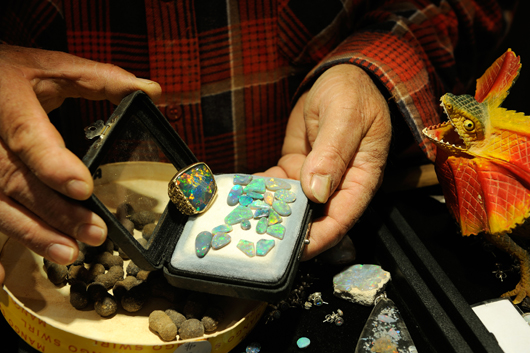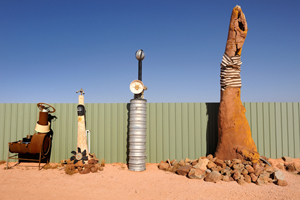A.bc
In Australia, sulle tracce di Chatwin 20 anni dopo Le Vie dei Canti
Palazzo delle Esposizioni, Roma
A.bc
In Australia, in Chatwin's footsteps 20 years after The Songlines Palazzo
Delle Esposizioni, Rome


István raccomanda di non muoversi troppo, «perché
sotto è tutto bucato, potrebbe crollare». La collina era
tutta sua e negli anni l’ha bucherellata con mille gallerie, alla
ricerca delle pietre. Poi ne ha vendute alcune parti; gli è rimasta
solo la cima, con al centro la sua casa a un piano trasformata in un laboratorio
da gioielliere e tutt’attorno un giardino con sculture fatte di
pietra, tastiere di computer, pezzi di motore, manichini. È arrivato
in Australia 50 anni fa. Era scappato dai carri armati sovietici che avevano
invaso la sua Ungheria nel 1956, diciottenne studente di medicina. «Alla
frontiera con l’Austria, i russi sparavano e dovevamo stare bassi.
Eravamo 200 in fuga, ma solo in sette ci siamo salvati». Dall’Austria
era poi passato in Francia, dove si fermò tre anni. «Per
raggiungere uno zio emigrato, mi imbarcai per Adelaide. Stavo per riprendere
gli studi in medicina, ma incredibilmente incontrai un amico di Budapest
che mi chiese se conoscevo l’opale. Mi disse di scordarmi l’università
perché sarei diventato un miliardario. I primi anni si trovava
poco. Ma tutta la collina era mia. Ho trovato le prime pietre mentre facevo
una buca per costruirmi un bagno»
Le sculture di István, esposte nel cortile di casa
Le sculture di István, esposte nel cortile di casa
István
advises us not to move too much, «because beneath us the ground
is full of holes and it could give way». The hill was his own propierty
and he has dug thousands of galleries through the years, searching for
stones. Then he sold some parts of the hills; he has only got the hilltop
now, with his one-storey house in the middle which has been made into
a jeweller’s laboratory. All around the house a garden with stone
sculptures, computer keyboards, pieces of car engines, dummies. He came
to Australia 50 years ago, escaping from the Soviet tanks that had invaded
his Hungary in 1956, when he was an eighteen-year-old medicin student.
«On the border with Austria, the Russians shot us and we had to
bend down. There were 200 of us, but only seven made it». From Austria
he then moved to France, where he stayed for three years. «I sailed
to Adelaide to join an uncle who had emigrated there. I was going to resume
my studies when, unbelievably, I met a friend from Budapest who asked
me if I had heard about opals. He told me to forget about university because
I would have soon become incredibly rich. The first years we couldn’t
find much. But I owned the whole hill. I found the first stones while
digging the ground to build a toilet»
István sculptures, exhibited in his courtyard
István sculptures, exhibited in his courtyard
